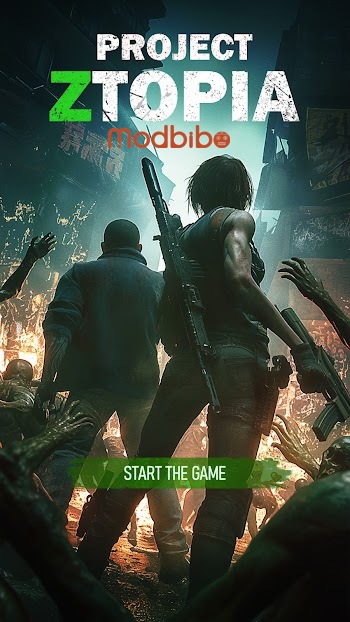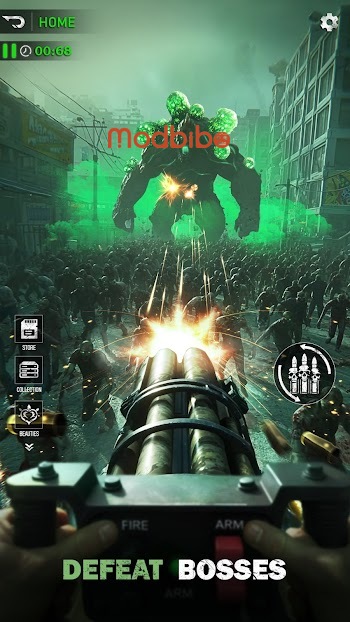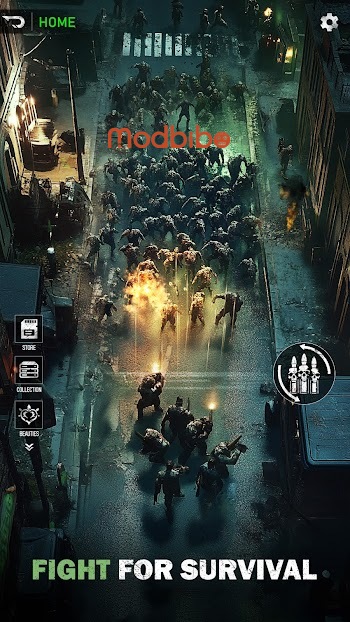
Project Ztopia
Advertisement
Games Overview
Project Ztopia APK is a futuristic sandbox survival game set in a post-apocalyptic world of AI and technology. Build bases, craft advanced tools, fight rogue machines.
Table of Contents
Project Ztopia APK – A Futuristic Sandbox Survival Experience
Project Ztopia APK stands out as one of the most ambitious sandbox survival games of recent years. Developed with cutting-edge design and built for mobile devices, Project Ztopia takes players into a futuristic open-world environment where technology, survival instincts, and creativity collide. It is not just another survival game — it’s a living digital ecosystem that adapts to your choices and evolves as you play.
This comprehensive analysis dives deep into the gameplay, mechanics, world design, narrative, features, and the immersive experience that defines Project Ztopia.
Overview of Project Ztopia APK
Project Ztopia is a sandbox survival game that blends open-world exploration, crafting, and futuristic storytelling. The game invites players into a massive virtual world, often described as a “technological wasteland” — a place where advanced civilization has collapsed, leaving scattered remnants of robotics, artificial intelligence, and cybernetic organisms.
At its core, the game is about adaptation and creation. Players start with minimal resources, then gather materials, craft tools, and construct advanced structures to survive in a hostile environment filled with unpredictable AI-driven creatures and environmental challenges.
Unlike many survival titles that rely on repetitive mechanics, Project Ztopia introduces dynamic ecosystems and AI simulation that make each playthrough unique. Weather systems, resource regeneration, and NPC behavior change according to player actions, ensuring no two experiences are ever identical.
The Setting – The World of Ztopia
The universe of Project Ztopia is set in a post-apocalyptic futuristic realm — a sprawling world combining dystopian cities, overgrown biomes, and derelict tech ruins. The developers emphasize realism blended with science fiction aesthetics, giving players a haunting yet beautiful environment to explore.
Each region of Ztopia carries distinct environmental hazards, resources, and lore. For instance:
-
The Iron Plains: once industrial zones, now abandoned and filled with scavenger robots.
-
The Crystal Forests: glowing bioluminescent trees that contain rare minerals and cyber-organic life.
-
The Wastes: vast desert-like areas where surviving rogue AIs hunt anything that moves.
-
The Sky Districts: floating city remnants accessible only through advanced crafting and jet propulsion technology.
Advertisement
Every location tells part of the story — through hidden data logs, remnants of ancient technology, and interactions with surviving sentient AIs.
Core Gameplay Mechanics
Project Ztopia follows the foundation of survival games — resource gathering, crafting, and combat — but enhances them with AI-driven complexity and modular building systems.
a. Resource Gathering and Crafting
The game features a tier-based crafting system that starts from primitive scavenging to advanced technological engineering. Players can harvest metal scraps, organic compounds, and digital components to build everything from simple shelters to autonomous drones.
Blueprints can be discovered or reverse-engineered from dismantled robots. The crafting interface is clean and intuitive, allowing both casual and experienced players to experiment freely.
b. Building and Construction
Building in Project Ztopia is not limited to static structures. Players can design modular bases, floating outposts, and even mobile fortresses powered by energy cores. Each piece can be customized with utilities such as solar panels, shield generators, AI assistants, and automated defense turrets.
The building physics system ensures realism — weight distribution, power consumption, and structure stability all influence how your base performs under pressure.
c. Combat System
Combat in Ztopia merges traditional survival mechanics with futuristic weaponry. Players can craft plasma blades, pulse rifles, EMP grenades, and cybernetic implants that enhance agility or perception.
The enemies vary from rogue machines to mutated fauna, each requiring unique tactics. The adaptive AI system ensures that enemies learn from your combat style — forcing players to diversify their strategies constantly.
d. Survival Elements
Environmental survival remains a key challenge. Players must monitor hunger, energy, temperature, and exposure to toxic elements. Weather conditions, such as acid rain or sandstorms, impact visibility and resource accessibility.
What sets Project Ztopia apart is its psychological survival meter, which measures mental stability. As players uncover dark truths about the world, their sanity may deteriorate — unlocking new abilities or hallucinations that alter gameplay perception.
Storyline and Narrative Depth
Unlike many open-world games that prioritize exploration over narrative, Project Ztopia integrates a deep, evolving storyline.
Players awaken in a decaying research facility with no memory of their identity. Through exploration and interaction with AI fragments, they gradually uncover the truth — they were once part of an experiment meant to merge human consciousness with artificial intelligence to create a new form of life.
The narrative unfolds through:
-
Data Archives: scattered terminals reveal the history of Ztopia’s collapse.
-
Holographic Echoes: ghost-like projections that replay key moments from the past.
-
AI Companions: sentient programs that guide or manipulate the player based on moral alignment.
Moral choices define the game’s outcome — whether you rebuild civilization, merge with the digital hive, or bring the system to total collapse.
Exploration and World Design
Exploration is one of Project Ztopia’s most rewarding features. The world is procedurally structured, ensuring immense replayability. Hidden vaults, experimental laboratories, and collapsed megastructures dot the landscape, each holding secrets and advanced technology.
Traversal mechanics are highly versatile. Players can use hoverboards, jetpacks, or teleport beacons to navigate the terrain. The transition between zones feels seamless, giving the illusion of an endless open world.
Dynamic day-night cycles and atmospheric lighting enhance immersion — sunsets casting neon reflections over broken towers or fog concealing lurking enemies in the distance.
Artificial Intelligence and NPC Systems
The AI system in Project Ztopia deserves special recognition. Every entity, from creatures to companion drones, operates under behavioral logic trees that simulate decision-making and adaptation.
NPCs in settlements develop memories and react differently based on your actions. Help a faction, and they provide protection and trade access; betray them, and you may face bounty hunters or sabotage attempts later.
Moreover, AI-driven “World Events” occur spontaneously — for example, a malfunctioning war mech might begin terrorizing nearby zones, forcing alliances or creating new quests.
Multiplayer and Co-op Functionality
Although primarily designed for single-player immersion, Project Ztopia offers optional co-op multiplayer where players can team up to explore, build bases, or fight large-scale threats together.
The multiplayer integration emphasizes cooperation rather than competition. Shared crafting systems, trade networks, and co-developed infrastructure make the experience feel communal.
In addition, PvP zones exist for players who prefer challenge and conflict. These areas reward rare resources but carry high risks of ambush and environmental hazards.
Customization and Progression
Player customization in Project Ztopia extends beyond appearance. Characters can modify their genetic code and cybernetic implants, unlocking new abilities such as night vision, kinetic shielding, or neural hacking.
Skill trees focus on four main disciplines:
Advertisement
-
Engineering: crafting advanced machinery and building structures.
-
Combat: mastering weapons and defense systems.
-
Survival: optimizing resource use and environmental endurance.
-
Cybernetics: manipulating AI systems and digital interfaces.
Every upgrade visually alters the character model, emphasizing the blend between human and machine.
Visuals and Sound Design
Project Ztopia sets a new bar for visual fidelity in mobile gaming. The graphics engine supports real-time lighting, dynamic particle effects, and volumetric weather systems, creating a console-like experience on Android devices.
Textures are meticulously detailed — rusted machinery, neon circuits, and synthetic landscapes feel alive. Animations are fluid, whether during combat, construction, or exploration.
Sound design complements the visuals perfectly. The ambient soundtrack shifts between melancholic synths and pulsating electronic beats depending on player location. Environmental sounds, such as mechanical hums or distant thunder, add depth and tension to the atmosphere.
Voice acting (for AI entities and holograms) enhances storytelling immersion, making every conversation feel emotionally charged and relevant.
Performance and Optimization
Despite its complexity, Project Ztopia runs efficiently on mid-range and high-end devices. The developers implemented scalable graphic settings, ensuring that users can adjust visual fidelity without sacrificing smooth performance.
Frame rates remain stable even in high-density areas filled with enemies or particle effects. Auto-saving and cloud sync prevent data loss, while regular updates fix bugs and add new content — proof of the developer’s commitment to longevity.
Player Community and Longevity
One of the strongest aspects of Project Ztopia is its community-driven evolution. Players contribute by sharing base blueprints, survival strategies, and custom AI scripts. Some in-game terminals even allow you to upload and test community-created modules.
Seasonal events, time-limited missions, and expansion packs ensure long-term engagement. Developers have hinted at future updates introducing space exploration and interdimensional rifts — expanding the lore beyond Earth-like biomes.
The balance between developer content and player creativity keeps the ecosystem alive and ever-evolving.
Why Project Ztopia Stands Out
While the market is saturated with survival and sandbox games, few achieve the balance of narrative depth, mechanical complexity, and emotional immersion that Project Ztopia offers.
Its unique selling points include:
-
AI-driven evolution: the world changes as players interact with it.
-
High replay value: every playthrough creates different story outcomes.
-
Advanced crafting and building mechanics: realistic systems that encourage experimentation.
-
Moral and psychological dimensions: survival is as mental as it is physical.
-
Cinematic presentation: AAA-quality graphics and sound on mobile devices.
Project Ztopia isn’t just a game — it’s an exploration of what it means to survive and create in a world ruled by artificial intelligence and human remnants.
Conclusion
Project Ztopia APK exemplifies the future of mobile gaming — intelligent, immersive, and emotionally resonant. It breaks traditional genre boundaries by fusing survival mechanics with narrative storytelling and cyber-futuristic world-building.
Players who enjoy games like No Man’s Sky, ARK: Survival Evolved, or Subnautica will find Project Ztopia familiar yet refreshingly innovative. Every decision matters, every structure tells a story, and every moment feels alive.








